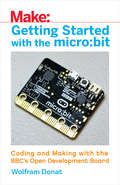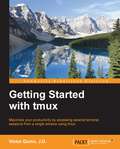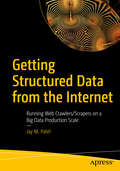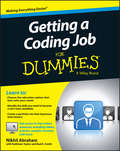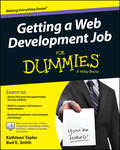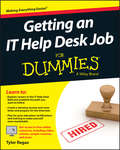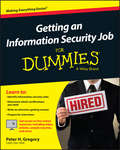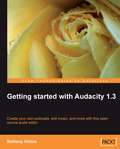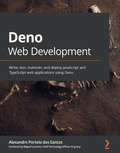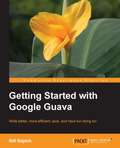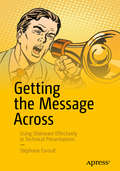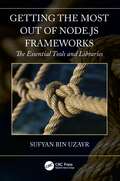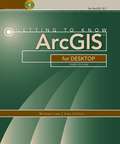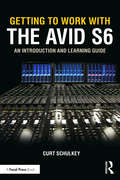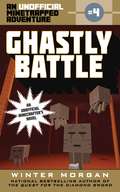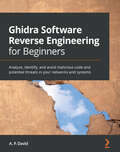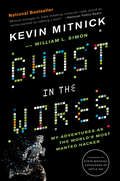- Table View
- List View
Getting Started with the micro: Coding and Making with the BBC's Open Development Board
by Wolfram DonatThe micro:bit, a tiny computer being distributed by the BBC to students all over the UK, is now available for anyone to purchase and play with. Its small size and low power requirements make it an ideal project platform for hobbyists and makers. You don't have to be limited by the web-based programming solutions, however: the hardware on the board is deceptively powerful, and this book will teach you how to really harness the power of the micro:bit. You'll learn about sensors, Bluetooth communications, and embedded operating systems, and along the way you'll develop an understanding of the next big thing in computers: the Internet of Things.
Getting Started with tmux
by Victor Quinn J.DThe book is intended for software developers, DevOps engineers, and other professionals who make heavy use of the terminal in their daily workflow. Some familiarity with the terminal is useful but no prior experience with tmux or other terminal multiplexers (such as GNU Screen) is required.
Getting Structured Data from the Internet: Running Web Crawlers/Scrapers on a Big Data Production Scale
by Jay M. PatelUtilize web scraping at scale to quickly get unlimited amounts of free data available on the web into a structured format. This book teaches you to use Python scripts to crawl through websites at scale and scrape data from HTML and JavaScript-enabled pages and convert it into structured data formats such as CSV, Excel, JSON, or load it into a SQL database of your choice. This book goes beyond the basics of web scraping and covers advanced topics such as natural language processing (NLP) and text analytics to extract names of people, places, email addresses, contact details, etc., from a page at production scale using distributed big data techniques on an Amazon Web Services (AWS)-based cloud infrastructure. It book covers developing a robust data processing and ingestion pipeline on the Common Crawl corpus, containing petabytes of data publicly available and a web crawl data set available on AWS's registry of open data.Getting Structured Data from the Internet also includes a step-by-step tutorial on deploying your own crawlers using a production web scraping framework (such as Scrapy) and dealing with real-world issues (such as breaking Captcha, proxy IP rotation, and more). Code used in the book is provided to help you understand the concepts in practice and write your own web crawler to power your business ideas. What You Will LearnUnderstand web scraping, its applications/uses, and how to avoid web scraping by hitting publicly available rest API endpoints to directly get dataDevelop a web scraper and crawler from scratch using lxml and BeautifulSoup library, and learn about scraping from JavaScript-enabled pages using SeleniumUse AWS-based cloud computing with EC2, S3, Athena, SQS, and SNS to analyze, extract, and store useful insights from crawled pagesUse SQL language on PostgreSQL running on Amazon Relational Database Service (RDS) and SQLite using SQLalchemyReview sci-kit learn, Gensim, and spaCy to perform NLP tasks on scraped web pages such as name entity recognition, topic clustering (Kmeans, Agglomerative Clustering), topic modeling (LDA, NMF, LSI), topic classification (naive Bayes, Gradient Boosting Classifier) and text similarity (cosine distance-based nearest neighbors)Handle web archival file formats and explore Common Crawl open data on AWSIllustrate practical applications for web crawl data by building a similar website tool and a technology profiler similar to builtwith.comWrite scripts to create a backlinks database on a web scale similar to Ahrefs.com, Moz.com, Majestic.com, etc., for search engine optimization (SEO), competitor research, and determining website domain authority and rankingUse web crawl data to build a news sentiment analysis system or alternative financial analysis covering stock market trading signalsWrite a production-ready crawler in Python using Scrapy framework and deal with practical workarounds for Captchas, IP rotation, and moreWho This Book Is ForPrimary audience: data analysts and scientists with little to no exposure to real-world data processing challenges, secondary: experienced software developers doing web-heavy data processing who need a primer, tertiary: business owners and startup founders who need to know more about implementation to better direct their technical team
Getting To Know ArcGIS Desktop
by Tim Ormsby Eileen J. Napoleon Robert Burke Carolyn Groessl Laura BowdenGetting to Know ArcGIS Desktop introduces principles of GIS as it teaches the mechanics of using ESRI's leading technology. Key concepts are combined with detailed illustrations and step-by-step exercises to acquaint readers with the building blocks of ArcGIS Desktop including ArcMap", for displaying and querying maps, ArcCatalog", for organizing geographic data, and Model Builder", for diagramming and processing solutions to complex spatial analysis problems. Its broad scope, simple style, and practical orientation make this book an ideal classroom text and an excellent resource for those learning GIS on their own. A data CD for working through the exercises and a fully functioning 180-day trial ArcGIS Desktop 10 software is included.
Getting Up To Speed The Future Of Supercomputing
by National Research Council of the National AcademiesSupercomputers play a significant and growing role in a variety of areas important to the nation. They are used to address challenging science and technology problems. In recent years, however, progress in supercomputing in the United States has slowed. The development of the Earth Simulator supercomputer by Japan that the United States could lose its competitive advantage and, more importantly, the national competence needed to achieve national goals. In the wake of this development, the Department of Energy asked the NRC to assess the state of U. S. supercomputing capabilities and relevant R&D. Subsequently, the Senate directed DOE in S. Rpt. 107-220 to ask the NRC to evaluate the Advanced Simulation and Computing program of the National Nuclear Security Administration at DOE in light of the development of the Earth Simulator. This report provides an assessment of the current status of supercomputing in the United States including a review of current demand and technology, infrastructure and institutions, and international activities.
Getting a Big Data Job For Dummies
by Jason WilliamsonHone your analytic talents and become part of the next big thingGetting a Big Data Job For Dummies is the ultimate guide to landing a position in one of the fastest-growing fields in the modern economy. Learn exactly what "big data" means, why it's so important across all industries, and how you can obtain one of the most sought-after skill sets of the decade. This book walks you through the process of identifying your ideal big data job, shaping the perfect resume, and nailing the interview, all in one easy-to-read guide.Companies from all industries, including finance, technology, medicine, and defense, are harnessing massive amounts of data to reap a competitive advantage. The demand for big data professionals is growing every year, and experts forecast an estimated 1.9 million additional U.S. jobs in big data by 2015. Whether your niche is developing the technology, handling the data, or analyzing the results, turning your attention to a career in big data can lead to a more secure, more lucrative career path. Getting a Big Data Job For Dummies provides an overview of the big data career arc, and then shows you how to get your foot in the door with topics like:The education you need to succeedThe range of big data career path optionsAn overview of major big data employersA plan to develop your job-landing strategyYour analytic inclinations may be your ticket to long-lasting success. In a highly competitive job market, developing your data skills can create a situation where you pick your employer rather than the other way around. If you're ready to get in on the ground floor of the next big thing, Getting a Big Data Job For Dummies will teach you everything you need to know to get started today.
Getting a Coding Job For Dummies
by Nikhil AbrahamYour friendly guide to getting a job in coding Getting a Coding Job For Dummies explains how a coder works in (or out of) an organization, the key skills any job requires, the basics of the technologies a coding pro will encounter, and how to find formal or informal ways to build your skills. Plus, it paints a picture of the world a coder lives in, outlines how to build a resume to land a coding job, and so much more. Coding is one of the most in-demand skills in today's job market, yet there seems to be an ongoing deficit of candidates qualified to take these jobs. Getting a Coding Job For Dummies provides a road map for students, post-grads, career switchers, and anyone else interested in starting a career in coding. Inside this friendly guide, you'll find the steps needed to learn the hard and soft skills of coding--and the world of programming at large. Along the way, you'll set a clear career path based on your goals and discover the resources that can best help you build your coding skills to make you a suitable job candidate. Covers the breadth of job opportunities as a coder Includes tips on educational resources for coders and ways to build a positive reputation Shows you how to research potential employers and impress interviewers Offers access to online video, articles, and sample resume templates If you're interested in pursuing a job in coding, but don't know the best way to get there, Getting a Coding Job For Dummies is your compass!
Getting a Networking Job For Dummies
by Peter H. Gregory Bill HughesEverything you need to start your career in computer networking Looking to land that computer networking position? Look no further! Getting a Networking Job For Dummies offers all the tools and step-by-step guidance you need to stand out from the crowd, get your foot in the door, and secure a job in this fast-growing sector. In no time, you'll get a handle on networking roles, necessary education, training, and certifications, ways to brand yourself for your dream career, and so much more. These days, computer networking can be a complicated industry, and knowing what you need to do to make yourself an attractive candidate for a coveted networking position can make all the difference. Luckily, Getting a Networking Job For Dummies arms you with everything you need to be one step ahead of the game. Humorous, practical, and packed with authoritative information, this down-to-earth guide is your go-to handbook for scoring that sought-after computer networking position! Find the right organization for you Write a winning resume that gets attention Answer difficult interview questions with confidence Identify required certifications to get the job you want If you're a prospective computer networking employee looking to present yourself as a strong, competitive candidate in the computer networking market, this hands-on guide sets you up for success.
Getting a Web Development Job For Dummies
by Bud E. Smith Kathleen TaylorCraving a career in web dev? Chart your path with this helpful guideGetting a Web Development Job For Dummies provides a roadmap to one of the "hot jobs" in the booming world of tech. The web development field is large, and it encompasses many actual functions. This book helps you understand the web development career opportunities and determine the path you should take, based on your own personal needs and preferences, to launch your career. You'll learn about various career options, the skills you'll need to become an attractive candidate, how to go about learning the ropes, and proving your abilities to a potential employer or client. With so many possible goals and no one right way to get there, this book cuts through the confusion to put you on the path to a career you want.The web development industry is expected to grow for the foreseeable future, and there is already a shortage of trained workers to fill the jobs. Whether you lean technical or aesthetic, you can find your place in the industry with right skills--both hard and soft--and with the right plan. Getting a Web Development Job For Dummies is your guide to formulating that plan and getting started right.Find formal or informal ways to build the tech skills you'll needDiscover where you fit, whether as a freelancer or within an organizationLearn how to build a resume, develop a portfolio, and impress interviewersGet expert tips on finding resources, building a reputation, and moreIf your pet peeves include malfunctioning forms, flashing banners, and sites that take way too long to load, the web development world needs you. But before you begin your journey, you need a destination and a route in mind. Getting a Web Development Job For Dummies is your roadmap, so you can set out today.
Getting an IT Help Desk Job For Dummies
by Tyler RegasStand out in one of IT's fastest growing job markets If you're looking for a job in IT, the help desk is the heart and soul of most IT operations, and an excellent starting point for a promising career. With the help of Getting an IT Help Desk Job For Dummies, you'll gain the knowledge and know-how to cut through the confusion of navigating the Information Technology job market. IT can be intimidating to hopeful-yet-inexperienced job candidates, but this guide will help you find and land the job of your dreams. Through easy-to-follow explanations, authoritative information, and a bit of humor, Getting an IT Help Desk Job For Dummies serves as your thorough and approachable guide to maximizing your competitive edge in this booming market. The IT job market has continued to expand as technology matures and deepens its roots in business operations. This is good news for you! However, it makes it that much harder to get a job in IT, as recent grads and other professionals are practically stampeding to get their feet in the door of this rapidly expanding industry. Luckily, Getting an IT Help Desk Job For Dummies gives you an advantage by providing expert instruction on how to score an interview and secure a job offer, the skills needed to obtain and maintain an IT position, and authoritative information on how to establish a career path in the IT field. Explore careers in the IT Help Desk field and establish the path you want to follow Plan for post-education certifications and training to make yourself more marketable Get expert guidance for creating a winning resume and cover letter Prepare for your IT Help Desk interview Loaded with simple, straight-forward advice, Getting an IT Help Desk Job For Dummies is your all-in-one guide to starting your IT career on the right foot!
Getting an Information Security Job For Dummies
by Peter H. GregoryGet prepared for your Information Security job search! Do you want to equip yourself with the knowledge necessary to succeed in the Information Security job market? If so, you've come to the right place. Packed with the latest and most effective strategies for landing a lucrative job in this popular and quickly-growing field, Getting an Information Security Job For Dummies provides no-nonsense guidance on everything you need to get ahead of the competition and launch yourself into your dream job as an Information Security (IS) guru. Inside, you'll discover the fascinating history, projected future, and current applications/issues in the IS field. Next, you'll get up to speed on the general educational concepts you'll be exposed to while earning your analyst certification and the technical requirements for obtaining an IS position. Finally, learn how to set yourself up for job hunting success with trusted and supportive guidance on creating a winning resume, gaining attention with your cover letter, following up after an initial interview, and much more. Covers the certifications needed for various jobs in the Information Security field Offers guidance on writing an attention-getting resume Provides access to helpful videos, along with other online bonus materials Offers advice on branding yourself and securing your future in Information Security If you're a student, recent graduate, or professional looking to break into the field of Information Security, this hands-on, friendly guide has you covered.
Getting started with Audacity 1.3
by Bethany HiitolaConversational and practical, this book is full of real life examples of where and how you would use the Audacity software. Not only does it give you task-based step-by-step instructions from installation to advanced audio editing techniques, it caters to the beginner to familiarize them with all the jargon, suggests recording equipment, it walks them through a simple sample project showing off everything Audacity can do. If you are new to audio recording and editing, and particularly using the Audacity software, this book is for you. It explains everything from common audio industry terms and software basics. Technical sound engineering details and jargon are omitted to keep the book friendly and easy to understand.
Getting started with Deno
by Alexandre SantosServer-side web development with Deno made easyKey FeaturesGet to grips with the essential concepts and techniques relating to DenoLearn how to use Deno in real-world scenariosDevelop, test and deploy web applications and tools using DenoBook DescriptionDeno is a modern and secure JavaScript and TypeScript runtime that evolved from Node.js. It leverages the features of modern JavaScript, adding a secure by default layer and shipping the complete toolset in the runtime binary.Getting Started with Deno will introduce Deno’s primitives and explain how you can use them to build real-world applications. The book starts by explaining the importance of Deno. You’ll explore Node.js, understanding its benefits and why its release took the world by storm. The chapters then go on to explain the purpose Deno serves in today’s world, including the need for security models and decentralized dependency management, neither of which exist in Node. Later, you’ll gain insights into Deno’s ecosystem and toolchain. In addition to this, you’ll get up to speed with writing simple CLI applications, while also exploring Deno APIs and standard modules. Toward the concluding chapters, you’ll be guided through the process of building a complete API with Deno.By the end of this Deno book, you’ll have learned how to use Deno to create and maintain secure and reliable applications.What you will learnUnderstand why you should use DenoGet to grips with tooling and the Deno ecosystemLeverage the standard library and Deno’s security modelExplore common practices and web frameworks to build a REST API in DenoImplement real-world functionalities in Deno through a step-by-step processUse dependency injection and inversion of control (IoC), along with exploring application architecture practicesTest and deploy a Deno application in isolation using DockerWho This Book Is ForThis book is for developers who want to leverage their JavaScript and TypeScript skills in a secure, simple, and modern runtime, using them for web application development. Although prior knowledge of Node.js is not necessary, it is recommended to easily get started with learning web development with Deno.Table of ContentsWhat is DenoThe toolchainRuntime and standard-libraryBuilding your first web applicationAdding Users and Migrating to OakAdding Authentication and Connecting to the DatabaseHTTPS, extracting configuration, and Deno oin the browserTesting - Unit and Integration Deploying a Deno applicationWrapping up
Getting started with Google Guava
by Bill BejeckThis is a short, practical guide, with lots of examples to help you learn Google Guava.There is no minimum level of experience required. There is something for everyone who works with Java, from the beginner to the expert programmer.
Getting started with IntelliJ IDEA
by Hudson Orsine AssumpcaoA practical, fast-paced guide with clear, step-by-step exercisesto help you understand the basics of IntelliJ Idea and develop a web application.This book will be ideal if you are a Java developer who has a little knowledge about IntelliJ and wants to get more information on using it to improve your development performance.
Getting the Message Across
by Stéphane FaroultCreate memorable presentations on technical and complex topics in slideware such as Microsoft PowerPoint and Apple’s Keynote for Mac. Learn good pacing and rhythm as well as judicious use of special effects.Whether the goal is to help a sale or to educate, and whether the final delivery is a live presentation, a webinar, or a short video presentation, this book focuses on the particular difficulties linked to technical presentations. You will learn to create a story when there is none, gain the interest of an audience who may not feel as strongly for the topic as the speaker does, turn abstract concepts into visual models, overcome the limitations of the medium (limited space, two dimensions), maintain interest through rhythm, and use effects, not to look cool or get that "WOW" moment, but to serve the message.Getting The Message Across presents a number of field-tested ideas for raising interest. The use of various techniques and careful scripting will help you, even if you aren't a natural-born show-person, to communicate effectively, and to make your audience remember your message, and not necessarily your slides. This book will teach you:Rhythm and animations, and the use of transitionsTo hold audience interest even with "dry" topicsTo create memorable presentationsTechniques useful for PowerPoint, Keynote for Mac, and any similar presentation medium or environmentWhat You Will LearnTurn austere topics into interesting stories.Give rhythm and pacing to your presentations.Build a narrative during transitions and animations.Hold audience interest and make listeners feel clever.Make people remember your presentation rather than your cool use of slideware.Who This Book Is ForPeople who have to communicate effectively on strongly technical topics. This book targets educators and trainers as well as technical consultants who need to present complex solutions to customers or leads, as well as would-be speakers at scientific or technical conferences. Getting The Message Across is a book for people who want to make their presentations not only more attractive, but really memorable. It is for people who aren't looking for a standing ovation, but who are willing to do what they can to be understood and to make their messages remembered. Getting The Message Across focuses on using slideware such as PowerPoint and Keynote. Such slideware, for all its flaws, is still one of the best ways to communicate, not only live, but also in dematerialized communications (webinars, video tutorials) for reaching an ever-growing audience.
Getting the Most out of Node.js Frameworks: The Essential Tools and Libraries
by Sufyan bin UzayrABOUT THE BOOK Gain the knowledge you need to navigate your way confidently through the ever-expanding landscape of modern JavaScript technologies. With more than 100 Node.js frameworks available and the number rising every month, it is becoming increasingly difficult to avoid JavaScript fatigue and keep abreast of the developments that are most useful and relevant to your own projects. In such a saturated environment, the knowledge of exactly which tools will best fit your goals is invaluable. This book will guide you through the quagmire by clearly and comprehensively outlining the most practically useful Node frameworks, libraries, and tools, as well as how they might be employed in your own projects. You will learn about JavaScript frameworks, including such as Polymer, Webix, Aurelia, Svelte, and Meteor. This book will empower you to cut through the noise and learn how to achieve your career goals with the right tools meant especially for you. WHAT WILL YOU LEARN The what, why and how behind a variety of JavaScript Node frameworks, including Polymer, Aurelia, and Svelte How to choose the right Node framework for different types of projects How to ensure server-side optimization is done correctly, even if you are not a server admin Guide to such JS tools as Gulp, Grunt, and npm WHO IS THIS BOOK FOR Web developers looking to learn JavaScript; web development beginners; JavaScript developers; and frontend developers.
Getting to Know ArcGIS Desktop (Getting to Know ArcGIS)
by Michael Law Amy CollinsBecoming the go-to person for ArcGIS Desktop? Start here. <p><p> This book is a comprehensive introduction to the features and tools of ArcGIS Desktop. Through hands-on exercises, readers will discover, use, make, and share maps with meaningful content. They will also learn how to build geodatabases, query data, analyze geospatial data, and more. The latest edition has been updated to the most current version of ArcGIS Desktop 10.6. <p><p> This book is suited for classroom use, independent study, and as a reference.
Getting to Know ArcGIS for Desktop (Getting to Know ArcGIS Series)
by Michael Law Amy CollinsGetting to Know ArcGIS for Desktop is a workbook for beginners. Its detailed, step-by-step exercises teach you the core functionality of ArcGIS for Desktop software: how to make maps, carry out spatial analysis, and build and edit spatial databases in the context of realistic projects. The exercises are supported by conceptual discussions at the start of each chapter and as needed throughout the book. Getting to Know ArcGIS for Desktop is a hands-on workbook that’s meant to be a practical manual for classroom lab work or on-the-job training. If you have no GIS background, chapter 1 will give you a quick overview. If you have no ArcGIS software experience, chapter 2 will provide a background on Esri GIS software products. The remaining 18 chapters require you to work through software exercises as you read. Each of these chapters contains two to four exercises that focus on a particular GIS task or problem. Many common tasks are covered, including navigating digital maps, finding GIS data online, setting map projections, symbolizing and labeling maps, classifying data, making map layouts, querying maps, analyzing spatial relationships, building spatial databases, editing data, and geocoding addresses. Each new exercise in Getting to Know ArcGIS for Desktop is a fresh starting point, with the maps and data you need already prepared for you. This volume is heavily revised for the third edition. New authors Michael Law and Amy Collins replaced a majority of the datasets for a fresh learning experience. All the exercises were designed for compatibility with ArcGIS 10.1 for Desktop. Although still intended for beginners, the content is no longer limited to the most basic functionality. Some advanced capabilities that are available with Standard and Advanced licenses are discussed. As the chapters progress, instructions and graphics become noticeably more streamlined, assuming increased knowledge and recall by readers as they move forward. Several new features have been added to the book to enhance the learning experience: learning objectives, chapter summaries, questions for critical thinking, software tips, independent-challenge tasks (“On your own"), a glossary of key terms, and navigation tabs.
Getting to Know Vue.js: Learn to Build Single Page Applications in Vue from Scratch
by Brett NelsonLearn how to render lists of items without repeating your code structure and how to work with conditional rendering items and event handling. Containing all you need to know to get started with Vue.js, this book will take you through using build tools (transpile to ES5), creating custom components, state management, and routers. With Getting to Know Vue.js, you'll see how to combine reusable code with custom components, allowing you to create snippets of reusable code to suit your specific business needs. You'll also explore how to use Single File Components and the Vue.js Command Line Interface (CLI) to build components in a single file and add in build tools as you see fit.Getting started with a new Single Page Application (SPA) JavaScript framework can be an overwhelming task, but Vue.js makes this daunting task simple and easy to learn, allowing you to start implementing business needs with just a script reference to the library and the custom JavaScript required for your use case. Starting with a little reference and a handful of lines of custom JavaScript, you will have a complete Single Page Application before you know it.What You'll LearnExamine Vue.js templating syntaxWork with binding methods Manage the state of your app by comparing your options of building a data store Adapt the more robust options compatible with Vue.jsReview different router options, including creating your own router, using the Vue-router and using Page.js. Who This Book Is For Software developers with an understanding of HTML, CSS and JavaScript; prior understanding of a Single Page Application framework would be useful but not essential.
Getting to Work with the Avid S6: An Introduction and Learning Guide
by Curt SchulkeyThis complete guide to the Avid S6 console offers the best techniques and practices from a seasoned industry veteran, Curt Schulkey, for utilizing its unique features and functions. The Avid S6 was created to be the industry standard virtual mixing console; however, it is so feature-packed that it can be difficult for new users to navigate. This book provides the ultimate guide to breaking down these amazing features and demonstrating how to use them effectively in your next project, with easy-to-follow instructions, rich illustrations, and general real-world advice from the author. This book takes students from neophyte to high-level intermediate. Readers should begin with a functional knowledge of Pro Tools and general understanding of mixing for cinema, but previous knowledge of mixing surfaces is not necessary as this book provides guidance through rudimentary, basic, and intermediary level workflows.
Getting to Yes with China in Cyberspace
by Martin C. Libicki Scott Warren Harold Astrid Stuth CevallosThis study explores U.S. policy options for managing cyberspace relations with China via agreements and norms of behavior. It considers two questions: Can negotiations lead to meaningful agreement on norms? If so, what does each side need to be prepared to exchange in order to achieve an acceptable outcome? This analysis should interest those concerned with U.S.-China relations and with developing norms of conduct in cyberspace.
Ghastly Battle (The Unofficial Minetrapped Adventure #4)
by Winter MorganPeace has been restored to the Overworld after an epic griefer battle. Lily, Simon, and Michael are glad to have a break from fighting, and even from their attempts to escape the game and return to their normal lives. <p><p> But then two new players are zapped onto the server, and no one’s sure who’s responsible for trapping them. With Mr. Anarchy and the other griefers in prison, anyone could be a suspect, and tempers flare as the townspeople’s suspicions turn inward. While Lily, Simon, and Michael are away seeking clues, the people of Lisimi Village turn against them, convinced that they’re keeping the knowledge of how to return home to themselves. Can the trio convince their friends of their innocence, bring the real villains to justice, and finally make their way home? <p> Friendships are tested and unlikely allies emerge in this thrilling fourth book in bestselling author Winter Morgan’s Unofficial Minetrapped Adventure series.
Ghidra Software Reverse Engineering for Beginners: Analyze, identify, and avoid malicious code and potential threats in your networks and systems
by A. P. DavidDetect potentials bugs in your code or program and develop your own tools using the Ghidra reverse engineering framework developed by the NSA projectKey FeaturesMake the most of Ghidra on different platforms such as Linux, Windows, and macOSLeverage a variety of plug-ins and extensions to perform disassembly, assembly, decompilation, and scriptingDiscover how you can meet your cybersecurity needs by creating custom patches and toolsBook DescriptionGhidra, an open source software reverse engineering (SRE) framework created by the NSA research directorate, enables users to analyze compiled code on any platform, whether Linux, Windows, or macOS. This book is a starting point for developers interested in leveraging Ghidra to create patches and extend tool capabilities to meet their cybersecurity needs.You'll begin by installing Ghidra and exploring its features, and gradually learn how to automate reverse engineering tasks using Ghidra plug-ins. You'll then see how to set up an environment to perform malware analysis using Ghidra and how to use it in the headless mode. As you progress, you'll use Ghidra scripting to automate the task of identifying vulnerabilities in executable binaries. The book also covers advanced topics such as developing Ghidra plug-ins, developing your own GUI, incorporating new process architectures if needed, and contributing to the Ghidra project.By the end of this Ghidra book, you'll have developed the skills you need to harness the power of Ghidra for analyzing and avoiding potential vulnerabilities in code and networks.What you will learnGet to grips with using Ghidra's features, plug-ins, and extensionsUnderstand how you can contribute to GhidraFocus on reverse engineering malware and perform binary auditingAutomate reverse engineering tasks with Ghidra plug-insBecome well-versed with developing your own Ghidra extensions, scripts, and featuresAutomate the task of looking for vulnerabilities in executable binaries using Ghidra scriptingFind out how to use Ghidra in the headless modeWho this book is forThis SRE book is for developers, software engineers, or any IT professional with some understanding of cybersecurity essentials. Prior knowledge of Java or Python, along with experience in programming or developing applications, is required before getting started with this book.
Ghost in the Wires: My Adventures as the World's Most Wanted Hacker
by William L. Simon Kevin Mitnick Steve WozniakKevin Mitnick was the most elusive computer break-in artist in history. He accessed computers and networks at the world's biggest companies--and however fast the authorities were, Mitnick was faster, sprinting through phone switches, computer systems, and cellular networks. He spent years skipping through cyberspace, always three steps ahead and labeled unstoppable. But for Kevin, hacking wasn't just about technological feats-it was an old fashioned confidence game that required guile and deception to trick the unwitting out of valuable information.Driven by a powerful urge to accomplish the impossible, Mitnick bypassed security systems and blazed into major organizations including Motorola, Sun Microsystems, and Pacific Bell. But as the FBI's net began to tighten, Kevin went on the run, engaging in an increasingly sophisticated cat and mouse game that led through false identities, a host of cities, plenty of close shaves, and an ultimate showdown with the Feds, who would stop at nothing to bring him down. Ghost in the Wires is a thrilling true story of intrigue, suspense, and unbelievable escape, and a portrait of a visionary whose creativity, skills, and persistence forced the authorities to rethink the way they pursued him, inspiring ripples that brought permanent changes in the way people and companies protect their most sensitive information.
